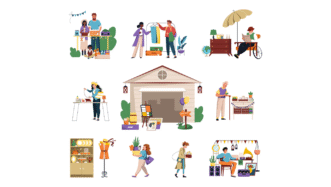LESSON OVERVIEW
The main objectives of this lesson are to:
- learn and practise useful vocabulary to describe experiences,
- discuss the ideas of home swapping and house sitting.
In this lesson students learn about home swapping and house sitting, watch a video and listen for specific information and learn vocabulary to talk about different experiences (e.g. handle an unexpected situation, meet expectations, a mixed experience, etc.). Students also play a quest game in which they make choices based on situations.
WARM-UP & VIDEO
This ESL lesson starts with a warm-up activity. Students discuss questions about homes and houses and their dream holiday accommodations. After the warm-up, students read some statements and decide which might be true about home swapping. Then, students watch the video and check their answers. Next, students complete the sentences with missing words and watch the video again to check if they were right. Before moving to useful vocabulary to describe experiences, students discuss questions and say whether home swapping/house sitting is popular where they live and brainstorm what can make these experiences positive or negative.
VOCABULARY TO DESCRIBE EXPERIENCES & QUEST GAME
In this part of the lesson, students look at the comments and decide whether they are positive or negative, about home swapping or house sitting, made by a guest or a homeowner. Then, they look at the comments again and match the phrases in bold (e.g. make an impression on someone, stress someone out, feel at home, etc.) to their meanings. To work more with the phrases, students complete the sentences with their ideas. As a wrap-up activity, they do a quest game in which they go through different scenarios connected to house sitting. You can also ask students to sum up their scenario using the vocabulary to describe experiences they’ve learned earlier.
HOMEWORK/REVISION
This lesson plan also includes an additional task that you can use as homework or revision. In the task, students complete the gaps with key vocabulary and create questions. The task is available in the teacher’s version of the worksheet. You can print it and hand it out to your students. It’s also included in the e-lesson plan.
Subscribe to unlock these and many other Standalone lesson lesson plans with the Unlimited planWORKSHEETS















Dear Inna,
Today I took this lesson, and it was fascinating and exciting because in my country, we don’t have such kinds of possibilities. So, the students can only search for information about home sitting and exchanging in English as an additional task. However, I am writing not only to provide positive feedback but also to address some confusion. I teach online, and when I reached the slide of the game, which is funny and makes this lesson very attractive, we realized that the order of slides was wrong. Could you make some corrections? Thank you very much!
Szilvia from Hungary
Thank you so much for your feedback! We’re happy your students enjoyed this topic. It’s great that English lessons help discover new things, isn’t it? 🙂 When it comes to the game, the slides are not supposed to be in a certain order as there are several scenarios that you can follow by choosing one of the options of answer to each question. Let us know if you need further clarifications regarding this activity 😉
Yeah, and it’s best to play it when in a presentation mode as then you choose a given option and it takes you to the correct card.
The video is unavailable.
Hi, Andrew! We found a different video and updated the worksheets. Everything should work fine now 🙂
The first ‘Journalist’ on page 29 is missing the answer. Kindly update this and advise asap. Thank you
Hello! Thank you for your comment, but we don’t quite understand your concern. The task consists in completing the answers of the ‘Home Swapper’ and then coming up with possible questions asked by the ‘Journalist’. The answer keys are revealed in the same order, namely, completed answers are on slides 29 and 30, then there are slides for the second part of the task (coming up with the relevant questions), and on slides 33 and 34 you can find suggestions for the questions. Hope this helps 🙂
Dear Inna,
Many thanks for your fast reply. My bad. I missed that the first time when I looked at it. Cheers!
Dear Inna,
this is an excellent lesson plan, also the game is a super idea, thank you!
Bye,
Nora from Hungary
Thank you for your comment, Nora! Happy you liked the lesson 🙂
The e-lesson is unavailable today
Hi! Please email us at [email protected] and explain what the issue is exactly so we can help. Thanks!